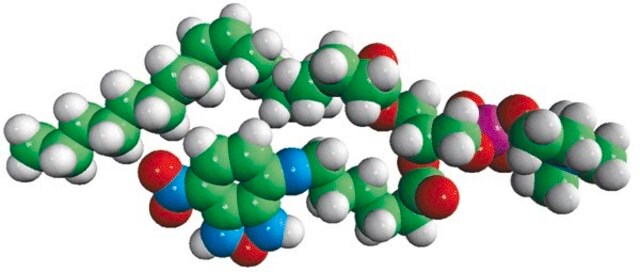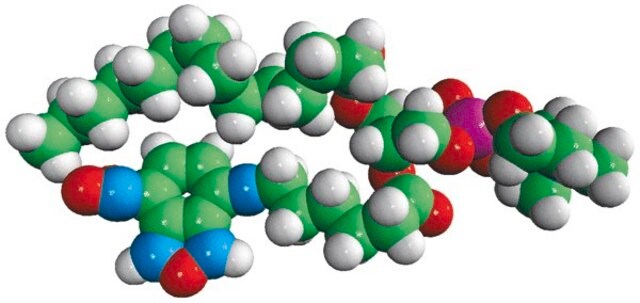810122C
Avanti
14:0-06:0 NBD PC
Avanti Research™ - A Croda Brand 810122C
Synonim(y):
1-myrystoilo-2-{6-[(7-nitro-2-1,3-benzoksadiazol-4-ylo)amino]heksanoilo}-sn-glicero-3-fosfocholina
About This Item
Polecane produkty
Próba
>99% (TLC)
Formularz
liquid
opakowanie
pkg of 1 × 1 mL (810122C-1mg)
pkg of 5 × 1 mL (810122C-5mg)
producent / nazwa handlowa
Avanti Research™ - A Croda Brand 810122C
stężenie
1 mg/mL (810122C-1mg)
1 mg/mL (810122C-5mg)
Warunki transportu
dry ice
temp. przechowywania
−20°C
Opis ogólny
Zastosowanie
- jako dodatek w lodowatej syntetycznej pożywce zdefiniowanej (SD) do hodowli drożdży do badań cytometrii przepływowej
- jako marker fluorescencyjny w pożywce na bazie hialuronianu i fosfolipidów (pożywka HA-fosfolipidowa) do hodowli komórek chrząstki i wizualizacji tworzenia pęcherzyków lipidowych
- w przygotowaniu małych pęcherzyków jednocząsteczkowych (SUV) i znakowanej fluorescencyjnie wspomaganej dwuwarstwy lipidowej (SLB) do odzyskiwania fluorescencji po badaniach fotowybielania (FRAP)
Działania biochem./fizjol.
Opakowanie
Informacje prawne
Hasło ostrzegawcze
Danger
Zwroty wskazujące rodzaj zagrożenia
Zwroty wskazujące środki ostrożności
Klasyfikacja zagrożeń
Acute Tox. 3 Inhalation - Acute Tox. 4 Oral - Carc. 2 - Eye Irrit. 2 - Repr. 2 - Skin Irrit. 2 - STOT RE 1 - STOT SE 3
Organy docelowe
Central nervous system
Klasa zagrożenia wodnego (WGK)
WGK 3
Wykazy regulacyjne
Wykazy regulacyjne dotyczą głównie produktów chemicznych. Można w nich podawać ograniczoną liczbę informacji na temat produktów niechemicznych. Brak wpisu oznacza, że żaden ze składników nie znajduje się w wykazie. Użytkownik odpowiada za zagwarantowanie bezpiecznego i zgodnego z prawem stosowania produktu.
EU REACH Annex XVII (Restriction List)
Wybierz jedną z najnowszych wersji:
Certyfikaty analizy (CoA)
It looks like we've run into a problem, but you can still download Certificates of Analysis from our Dokumenty section.
Proszę o kontakt, jeśli potrzebna jest pomoc Obsługa Klienta
Masz już ten produkt?
Dokumenty związane z niedawno zakupionymi produktami zostały zamieszczone w Bibliotece dokumentów.
Nasz zespół naukowców ma doświadczenie we wszystkich obszarach badań, w tym w naukach przyrodniczych, materiałoznawstwie, syntezie chemicznej, chromatografii, analityce i wielu innych dziedzinach.
Skontaktuj się z zespołem ds. pomocy technicznej










